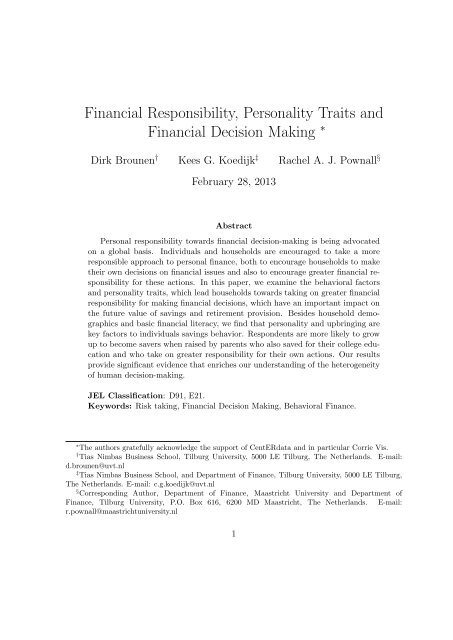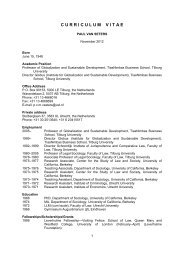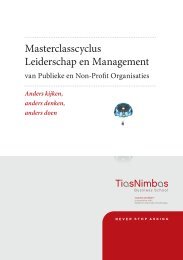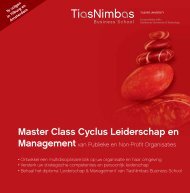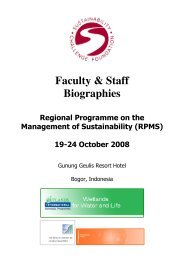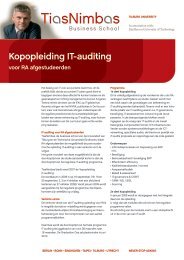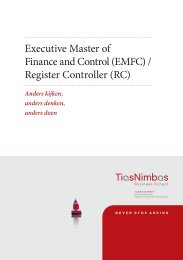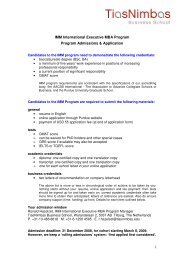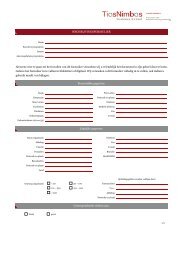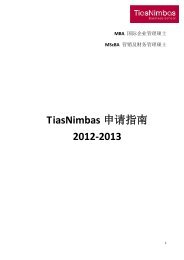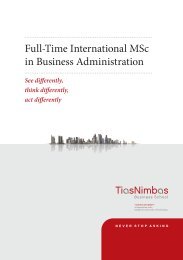Financial Responsibility, Personality Traits and Financial Decision ...
Financial Responsibility, Personality Traits and Financial Decision ...
Financial Responsibility, Personality Traits and Financial Decision ...
You also want an ePaper? Increase the reach of your titles
YUMPU automatically turns print PDFs into web optimized ePapers that Google loves.
<strong>Financial</strong> <strong>Responsibility</strong>, <strong>Personality</strong> <strong>Traits</strong> <strong>and</strong><br />
<strong>Financial</strong> <strong>Decision</strong> Making ∗<br />
Dirk Brounen † Kees G. Koedijk ‡ Rachel A. J. Pownall §<br />
February 28, 2013<br />
Abstract<br />
Personal responsibility towards financial decision-making is being advocated<br />
on a global basis. Individuals <strong>and</strong> households are encouraged to take a more<br />
responsible approach to personal finance, both to encourage households to make<br />
their own decisions on financial issues <strong>and</strong> also to encourage greater financial responsibility<br />
for these actions. In this paper, we examine the behavioral factors<br />
<strong>and</strong> personality traits, which lead households towards taking on greater financial<br />
responsibility for making financial decisions, which have an important impact on<br />
the future value of savings <strong>and</strong> retirement provision. Besides household demographics<br />
<strong>and</strong> basic financial literacy, we find that personality <strong>and</strong> upbringing are<br />
key factors to individuals savings behavior. Respondents are more likely to grow<br />
up to become savers when raised by parents who also saved for their college education<br />
<strong>and</strong> who take on greater responsibility for their own actions. Our results<br />
provide significant evidence that enriches our underst<strong>and</strong>ing of the heterogeneity<br />
of human decision-making.<br />
JEL Classification: D91, E21.<br />
Keywords: Risk taking, <strong>Financial</strong> <strong>Decision</strong> Making, Behavioral Finance.<br />
∗The authors gratefully acknowledge the support of CentERdata <strong>and</strong> in particular Corrie Vis.<br />
† Tias Nimbas Business School, Tilburg University, 5000 LE Tilburg, The Netherl<strong>and</strong>s.<br />
d.brounen@uvt.nl<br />
E-mail:<br />
‡ Tias Nimbas Business School, <strong>and</strong> Department of Finance, Tilburg University, 5000 LE Tilburg,<br />
The Netherl<strong>and</strong>s. E-mail: c.g.koedijk@uvt.nl<br />
§ Corresponding Author, Department of Finance, Maastricht University <strong>and</strong> Department of<br />
Finance, Tilburg University, P.O. Box 616, 6200 MD Maastricht, The Netherl<strong>and</strong>s.<br />
r.pownall@maastrichtuniversity.nl<br />
E-mail:<br />
1
During the past decade, governments around the globe have started advocating a<br />
new <strong>and</strong> responsible approach to personal finance, to encourage households to be more<br />
in charge of their own financial situation. The 2008 financial crisis <strong>and</strong> the recession<br />
that followed hit families hard, <strong>and</strong> has shifted government policy away from promoting<br />
cheap financing, more often used for increased consumer spending towards enhancing<br />
consumer awareness of individuals long term financial needs <strong>and</strong> resources. This shift<br />
increases the importance of financial responsibility, <strong>and</strong> to a large extent depends on<br />
the financial literacy of households. We aim to investigate if financial knowledge <strong>and</strong><br />
financial awareness is a first condition for acting more responsibly, or if personality<br />
traits <strong>and</strong> upbringing are more important factors in this process.<br />
Demographic ageing is one of many social trends that is putting additional pressure<br />
on the financial sustainability of conventional healthcare <strong>and</strong> pension plans. As the pro-<br />
portion of elderly rises steadily, costs are approaching levels that can no longer be borne<br />
by national government budgets alone. As a consequence, households are also forced to<br />
take financial matters more into their own h<strong>and</strong>s. Theoretical life cycle models predict<br />
that consumers smooth consumption over their lifetime, assuming that consumers are<br />
forward looking <strong>and</strong> make plans for the future . But whether households are actually<br />
able <strong>and</strong> ready to manage their long-term financing responsibly is doubtful. Campbell<br />
(2006) already points out that it is often difficult for consumers to exhibit carefully<br />
reasoned <strong>and</strong> informed economic decisions. Lusardi <strong>and</strong> Mitchell (2007) show that 45<br />
per cent of baby-boomers in the age bracket 51-56 have done little or no retirement<br />
planning at all, <strong>and</strong> as a result they enter their golden years with low levels of wealth.<br />
One important factor that triggers the extent of financial planning is financial literacy<br />
the set of skills <strong>and</strong> knowledge that allows an individual to make informed <strong>and</strong> effective<br />
2
decisions through their underst<strong>and</strong>ing of finances. Using a set of carefully constructed<br />
survey question Lusardi <strong>and</strong> Mitchell (2007) calibrate a measure for the level of finan-<br />
cial literacy on a household level, <strong>and</strong> find empirical evidence that financial literacy is<br />
an important aspect for taking decisions towards financial planning for the future.<br />
<strong>Financial</strong> Literacy is not a new concept. In 2003 the Organization for Economic<br />
Co-operation <strong>and</strong> Development (OECD) started an intergovernmental financial liter-<br />
acy project. The main objective of this project is to provide ways to improve financial<br />
education <strong>and</strong> literacy st<strong>and</strong>ards through the development of common financial literacy<br />
principles. In late 2005 an international OECD survey study showed that 67 per cent<br />
of Australian respondents indicated that they understood the principle of compound<br />
interest, yet when they were asked to solve a problem using this concept only 28 per<br />
cent had a good level of underst<strong>and</strong>ing. Results showed that British respondents do<br />
not actively seek out financial information. Instead, the information that they did<br />
acquire was collected on the off- chance, for example by picking up a pamphlet at a<br />
bank. Results from the Canadian survey showed that respondents considered invest-<br />
ment choice to be more stressful than going to the dentist. These compelling results<br />
have attracted the attention of policymakers, as new acts <strong>and</strong> taskforces have been put<br />
in place to promote financial planning <strong>and</strong> capabilities. Whilst on the one h<strong>and</strong> we<br />
wish to promote as a society individual choice <strong>and</strong> taking into account our own finances<br />
in a responsible manner, unless we have the correct knowledge, literacy <strong>and</strong> ability to<br />
do so, then there still remains a role for government intervention <strong>and</strong> regulation on<br />
savings behavior at the national level. To be able to shed greater light on policy mak-<br />
ing in this area we need to underst<strong>and</strong> attitudes towards financial decision-making <strong>and</strong><br />
savings behavior in greater depth. Behavioral finance allows for individual heterogene-<br />
3
ity in financial decision-making. In this paper we build upon the current literature in<br />
behavioral finance to address whether in addition to levels of financial literacy finan-<br />
cial decision-making is due to personality traits <strong>and</strong> upbringing. Once controlling for<br />
the household demographics does financial literacy, financial awareness <strong>and</strong> financial<br />
underst<strong>and</strong>ing improve financial decision making towards future savings behavior? Fu-<br />
ture schemes targeted to improve financial literacy on a national level will only make a<br />
significant impact for those individuals who also take on the responsibility towards any<br />
financial decisions made. We address this issue directly by looking into greater detail<br />
how personality <strong>and</strong> attitudes from upbringing influences the heterogeneity in finan-<br />
cial decision. We take an important step towards further underst<strong>and</strong>ing the process of<br />
human financial decision-making <strong>and</strong> the subsequent implications for financial markets.<br />
We therefore extend the current analyses on financial decision making by exploring<br />
a wider set of explanatory factors that help to explain household saving behavior in the<br />
cross section <strong>and</strong> that can help to enhance financial responsibility levels in the future.<br />
In line with Lusardi <strong>and</strong> Mitchell (2007), we first construct survey questions with which<br />
we measure the financial literacy of our respondents a set of 1,721 Dutch households.<br />
Further to the current research we include additional variables <strong>and</strong> constructs to mea-<br />
sure the impact of both upbringing <strong>and</strong> personality on financial decision making. Our<br />
extended survey puts us in the unique position to simultaneously analyze <strong>and</strong> weigh the<br />
effects of household demographics, upbringing, skills <strong>and</strong> interests, <strong>and</strong> personality into<br />
the current research in this area. Our results are both intriguing <strong>and</strong> intuitive at the<br />
same time. We find empirical support that savings behavior depends on financial liter-<br />
acy. The higher the level of financial literacy, the more likely that the individual will<br />
both reportedly <strong>and</strong> actually save. Those people who score above 85% on the financial<br />
4
literacy test are 38% more likely to save than those who score below this level. Using<br />
survey data to construct a measure of the internal locus of control which is domain<br />
specific to financial decisions, we find strong supportive evidence that those people who<br />
score high on this construct are 40% more likely to save. The importance of financial<br />
literacy drops slightly but is still statistically significant <strong>and</strong> highly relevant. Whilst<br />
for those people who take external factors more into account <strong>and</strong> believe in matters<br />
out of their own h<strong>and</strong>s playing a larger role in determining the outcome of ending up<br />
rich in life, the likelihood of saving for the future drops by 30%. We find considerable<br />
support after taking into account household demographics <strong>and</strong> financial literacy, skills<br />
<strong>and</strong> interests, that taking on financial responsibility for ones own financial situation has<br />
extremely important consequences for savings levels.<br />
The remainder of this paper is organized as follows: the next section describes the<br />
data <strong>and</strong> provides descriptive statistics <strong>and</strong> details regarding the setup of the survey<br />
analysis. Section three provides the empirical results explaining financial literacy, while<br />
section five focuses on the effects of financial literacy on financial planning <strong>and</strong> decision<br />
making. Section five is a brief conclusion.<br />
1 The Evolution of Savings Behavior <strong>and</strong> <strong>Financial</strong><br />
Literacy<br />
Whether or not households save money is a choice that was first addressed in the<br />
economics literature when Ramsey (1928) <strong>and</strong> Fischer (1930) introduced their infinite<br />
<strong>and</strong> finite life-cycle models. This framework offered a new st<strong>and</strong>ard for economists to<br />
think about the intertemporal allocation of time, effort <strong>and</strong> money. In its most general<br />
5
formulation, this life-cycle framework asserts that agents make sequential decisions to<br />
achieve a coherent goal using all the information that is available to them. Along these<br />
lines, households ought to have active savings management that helps them to smooth-<br />
ing out their consumption over their lifespan. Over the years this life-cycle model has<br />
been extended <strong>and</strong> enriched, allowing for potentially important features such as habits,<br />
imperfection in capital markets, disagreements between husb<strong>and</strong>s <strong>and</strong> wives about how<br />
much to save, limited computational powers, <strong>and</strong> discounting of the future that changes<br />
over time . An exp<strong>and</strong>ing body of mostly normative literature has evolved in this field,<br />
to explain how households should behave to obtain optimal savings behavior <strong>and</strong> port-<br />
folio choice over the life cycle. In his seminal work on household finance, Campbell<br />
(2006) compared what we know about what households actually do with our body of<br />
knowledge about what households should do. He argues that although many households<br />
find adequate solutions to the complex investment problems they face, some households<br />
make serious investment mistakes. These mistakes are made more often by poorer <strong>and</strong><br />
less educated households, supporting the recent call for financial education <strong>and</strong> stricter<br />
consumer regulations. The lack of financial literacy among some consumers was first<br />
documented by Bernheim (1995, 1998). Hilgert et al (2003) report that most Americans<br />
fail to underst<strong>and</strong> basic financial concepts, particularly those related to bonds, stocks,<br />
<strong>and</strong> mutual funds. Lusardi <strong>and</strong> Mitchells (2006) module on planning <strong>and</strong> financial liter-<br />
acy of the 2004 Health <strong>and</strong> Retirement Study (HRS) show that many older individuals<br />
cannot do simple interest-rate calculations, <strong>and</strong> do not underst<strong>and</strong> inflation. Using a<br />
financial literacy construct based on a small set of numerical exercises, they conclude<br />
that financial literacy is very low among women, those with low educations <strong>and</strong> Afro-<br />
Americans <strong>and</strong> Hispanics. As a result, these financial illiterates fail to plan <strong>and</strong> save<br />
6
for their retirement, <strong>and</strong> thereby run the risk of falling short later in life. Recent work<br />
by Huston (2010) sheds new light on measurement issues regarding financial literacy<br />
<strong>and</strong> knowledge. Important here is the distinction between two dimensions underst<strong>and</strong>-<br />
ing (personal finance knowledge) <strong>and</strong> use (personal finance application). Most of the<br />
available literature on financial literacy is focused on the first, the underst<strong>and</strong>ing, <strong>and</strong><br />
relates the variation in financial underst<strong>and</strong>ing to a set of demographics. Alternatively,<br />
in the field of psychology various behavioral factors have been identified that explain<br />
use, <strong>and</strong> effectively may help us to underst<strong>and</strong> why some households plan <strong>and</strong> actually<br />
save for retirement while other do not. Thaler (1994) <strong>and</strong> Levin (1998) have incorpo-<br />
rated behavioral aspects as bounded rationality, limited self-control, <strong>and</strong> the fungibility<br />
of assets, into the life-cycle model. An important concept in this area is the locus of<br />
control the extent to which individuals believe that they can control events that af-<br />
fect them. This concept was first developed by Rotter (1966) <strong>and</strong> became popular in<br />
behavioral psychology. Although the concept <strong>and</strong> the various scales measuring it have<br />
been subjected to extensive assessment <strong>and</strong> criticism, it has been applied in various ar-<br />
eas of health science, religious beliefs <strong>and</strong> behaviors, political sciences <strong>and</strong> educational<br />
settings . So far, this locus of control has not been applied in the financial literature<br />
on household finance. In this paper, we integrate the locus of control concept into an<br />
empirical analysis of household savings. We build on the available work on life-cycle<br />
models <strong>and</strong> financial literacy by applying a framework that considers both demograph-<br />
ics, upbringing, skills, but perhaps most notably a set of personality variables that can<br />
help our underst<strong>and</strong>ing of why the use of personal finance knowledge.<br />
7
2 Data<br />
We use data from the 2011 Dutch National Bank Household Survey (DHS). DHS is<br />
a long-st<strong>and</strong>ing, annual household survey that includes extensive information about<br />
demographic <strong>and</strong> economic household characteristics, focusing on wealth <strong>and</strong> savings<br />
data. The data set is representative of the Dutch population, <strong>and</strong> it contains over<br />
2,000 households. The DHS is built up in several sections. Section A inquires about<br />
the financial background of the respondent (i.e., income, savings, spending behavior,<br />
etc.). Section B focuses on whether households rely on external advice for their financial<br />
matters. Section C deals with the pension plan of the household, while section D asks<br />
questions with respect to housing <strong>and</strong> mortgage details. In addition to using data from<br />
the core of the DHS, we also use data from additional, self-designed survey modules<br />
on financial literacy <strong>and</strong> saving behavior, added to the survey in April 2011. This<br />
final section of the survey is designed to assess ability of households to properly make<br />
financial decisions <strong>and</strong> to trade off long-term benefits with short-term investments.<br />
Our dataset also benefits from existing survey data <strong>and</strong> background characteristics on<br />
the panel, enriching our survey results with additional background items that were<br />
addressed in other DHS surveys over 2011. The most important set of items here, is<br />
a set of 13 locus of financial control questions that is part of the regular assets <strong>and</strong><br />
loans section of DHS <strong>and</strong> that has been validated in earlier studies . The first seven<br />
questions are designed to measure the internal locus of control. Averaging the scores<br />
on these questions results in a construct for the belief that one determines ones own<br />
economic fate. The remaining 6 questions measure the belief that chance determines<br />
ones economic fate, hence are averaged in what we refer to as the chance construct. See<br />
Furnham (1986) for an overview of the approach.<br />
8
In total, the survey consists of 62 questions, <strong>and</strong> requires 18 minutes to complete,<br />
on average. Survey participants are interviewed via the Internet. A total of 1,721 out<br />
of 2,028 households completed the financial literacy module – a response rate of 84.9<br />
percent (in line with the response rate for the main survey).<br />
Table 1 reports summary statistics of the main variables of our survey. Here we<br />
report items in four clusters, representing the life-cycle <strong>and</strong> personality of the respon-<br />
dents; variables relating to the household demographics (section A), variables related to<br />
their youth <strong>and</strong> upbringing (section B), variables related to their education, skills, <strong>and</strong><br />
interests (section C), <strong>and</strong> variables related to their personality <strong>and</strong> attitude (section D).<br />
In section E, we report statistics on the respondents savings behavior. The variables<br />
of section A are most common in the literature on financial literacy <strong>and</strong> education. In<br />
the cluster of youth <strong>and</strong> upbringing, we seek for effects that parents may have had on<br />
the savings behavior (while controlling for generational effects) of their offspring. In<br />
the third cluster we group variables that indicate the skills of the respondent, which are<br />
partly trained by education <strong>and</strong> partly developed by personal interests. Here, we also<br />
include the financial literacy construct of Lusardi <strong>and</strong> Mitchell (2007). In section E,<br />
we group variables that are inspired by the behavioral psychology literature. Here we<br />
test whether saving behavior coincides with personality features like optimism, being<br />
organized, <strong>and</strong> a strong locus of control. The statistics in Table 1 are presented for<br />
the full sample of 1,721 respondents, <strong>and</strong> for two sub groups the spenders versus the<br />
savers. We define these sub groups based on the respondents reply to the question<br />
that measures the extent to which they are willing to sacrifice immediate wellbeing to<br />
achieve future results. Savers are the group that scores high on this question, while the<br />
reverse is true for spenders.<br />
9
Table 1— Summary statistics (n=1,721)<br />
Section A shows that the 54.17 percent of our respondents is male, <strong>and</strong> that the average<br />
respondent is 57 years of age, lives in a household of 2.40 persons, has 0.62 children <strong>and</strong><br />
earns 1845 Euros net of tax every month. Besides the age structure, these characteristics<br />
coincide strongly with the averages for the Dutch society at large. DHS respondents<br />
are older than the average person in the Netherl<strong>and</strong>s, since the panel was constructed<br />
in the early 80s <strong>and</strong> has gradually aged ever since. Here, we also find that spenders are<br />
slightly older than the sample average, while savers earn the highest net income.<br />
Figure 1— Self reported savers (n=1,721)<br />
To briefly highlight some of the demographics of the self reported savers versus spenders,<br />
we plot the fraction of savers in our sample across age, gender, household size, <strong>and</strong><br />
income groups in figure 2. This illustrates the results of section A of table 1 <strong>and</strong> shows<br />
that men do not consider themselves as significantly greater savers than women, but<br />
this tendency does increases with age, household size <strong>and</strong> income.<br />
In section B of table 1, we find that the majority of our respondents were born<br />
in the era after the second world war; that 25.83 percent of respondents were born<br />
into a family that was better off than average; that 53.75 percent received pocket<br />
money from their parents at the age of twelve; <strong>and</strong> that 21.26 percent had parents<br />
that saved for their education. These statistics vary across savers <strong>and</strong> spenders. We<br />
find more savers from younger generations, <strong>and</strong> we find that these savers were more<br />
often born into families that were better off than average, with parents that saved<br />
more often for their education, <strong>and</strong> that were more likely to h<strong>and</strong> out pocket money,<br />
when compared to spenders. Section C shows that after youth 39.40 percent of our<br />
respondents enjoyed some college education. 27.14 percent of our respondents claim to<br />
10
e good at mathematics, <strong>and</strong> merely 10.51 percent keeps up with the financial news, <strong>and</strong><br />
71.47 percent of our respondents manage the financial administration in the household.<br />
We posed each respondent the same six financial literacy questions as used by Lusardi<br />
<strong>and</strong> Mitchell (2007) <strong>and</strong> 4.18 were answered correctly, on average. This score, on<br />
the scale of six, we use as a financial literacy construct throughout our analysis. In<br />
Appendix C, we state the scores on each of these six questions separately <strong>and</strong> we plot<br />
the subsamples based on the respondents gender, age, mathematical skills set, <strong>and</strong><br />
financial interests. Here we find that the variation in this financial literacy construct<br />
results mainly from one of the six questions (the one in which we ask respondents on<br />
the consequence of a jump in inflation for the value of bonds). When considering these<br />
plots, we learn that this question is answered correctly mostly by the respondents that<br />
keep up with the financial news, more so than those that are good in math. For the<br />
savers in our sample this financial literacy score was only slightly higher, while the<br />
overall level of education, financial interest, <strong>and</strong> mathematical skill set exceeded the<br />
sample average more pervasively.<br />
Finally, when considering several personality <strong>and</strong> attitude characteristics across our<br />
sample we find that 57.60 percent of our respondents define themselves as religious,<br />
26.79 percent have a left wing political preference, 36.63 percent have positive economic<br />
expectations, 62.88 percent keep a tight financial administration <strong>and</strong> only 9.00 percent<br />
like taking financial risks. Across the two sub groups of savers <strong>and</strong> spenders we find<br />
that the self proclaimed savers are more positive about the economic outlook, are more<br />
on top of their financial administration <strong>and</strong> are more likely to vote for centre-leftwing<br />
parties during elections. Perhaps the two most noteworthy variables of table 1 are those<br />
positioned at the bottom of the table the internal locus of financial control <strong>and</strong> the<br />
11
chance construct score. As discussed before, both measure the belief of respondents to<br />
capture how much their actions affect their own financial wellbeing versus their belief<br />
that their future is determined more by faith than by themselves. These measures<br />
capture the extent to which individuals are willing to take on the responsibility of<br />
financial decisions by their own accord. Instead of looking at the levels of each, it is<br />
more interesting to directly focus on the differences between the sub groups. We find<br />
that this locus of financial control is higher amongst savers, while the chance score is<br />
higher for spenders. In both cases these differences are statistically significant <strong>and</strong> in<br />
line with expectations. Savers would save less if they thought that it was chance that<br />
would determine their futures.<br />
Table 2— Correlation table (n=1,721)<br />
Obviously, some of these characteristics of our respondents are related. Hence, be-<br />
fore we take our dataset any further we first consider the correlation coefficients given<br />
in table 2. Beyond some obvious relationships between items like the number of chil-<br />
dren <strong>and</strong> household size, age of respondents <strong>and</strong> their distribution across generations,<br />
we also document some correlations that require our attention. For instance, for older<br />
respondents, political inclination <strong>and</strong> religious belief increases, as well as the belief in<br />
external factors. However older people are less positive about the economy. This may<br />
be driven by the generation born before the war, which we will control for later. Male<br />
respondents are higher risk takers, which is well documented in the literature. However,<br />
they also take greater internal control for their finances. Indeed risk taking is statis-<br />
tically positively correlated with taking financial control, <strong>and</strong> with degree of financial<br />
literacy, the extent to which this is driven by male respondents <strong>and</strong> other factors will be<br />
12
looked at in detail later, <strong>and</strong> is of particular interest here for our discussion on financial<br />
decision making.<br />
We also find weak correlations between (not reported here) respondents who feel<br />
that their parents were better off than average are more likely that these parents saved<br />
for their education <strong>and</strong> gave pocket money to them on a regular basis. Respondents<br />
who are good at mathematics are also more likely to keep tight financial administra-<br />
tion, <strong>and</strong> respondents who keep up with the financial news are more willing to take<br />
financial risks. Regarding the internal locus of financial control, we notice that if this is<br />
higher for respondents who keep up with the financial news, which is intuitively more<br />
relevant, when you believe that your financial actions matter. Finally with respect to<br />
the chance score, we find that this is lower among the more highly educated <strong>and</strong> among<br />
the respondents that received pocket money. 1<br />
3 Empirical Analysis<br />
Before we start to disentangle the various factors that determine financial planning <strong>and</strong><br />
decision-making, we first start with a short robustness test. In line with Huston (2010),<br />
we would like to make a distinction between what people say <strong>and</strong> what they do under-<br />
st<strong>and</strong>ing versus use. In this case, we may well be confronted with a significant response<br />
bias, as saving <strong>and</strong> spending both carry different moral loadings. So far, we have fo-<br />
cused our attention on dividing the sample based on how respondents have replied when<br />
asked to what extent they are willing to sacrifice immediate wellbeing in order to achieve<br />
future results. The highest scoring respondents (5 or higher of a 7 point scale) are cat-<br />
egorized as savers, while for those whose score did not exceed 3 on the 7 point scale are<br />
1 Further correlations are available on request.<br />
13
eferred to as spenders. These qualifications, however, are to some extent self selected<br />
by the respondents. Hence, we also included a set of questions that address observable<br />
savings behavior. Spread evenly across the survey we ask the respondents the following:<br />
Q: Have you earned more than you spent during last 12 months?<br />
Q: Do you have enough savings to last one year without income?<br />
Q: Do you save for your retirement?<br />
Q: Do you read your annual pension statement?<br />
These questions are all designed to detect actual savings behavior. In table 3, we<br />
report the scores on each of these four questions, again for the total sample as well<br />
as for the two sub groups of self reported savers <strong>and</strong> spenders. In section A of the<br />
table we discuss the results for each questions separately. Overall, this shows that<br />
46.55 percent of our respondents have spent more than they have earned, 30.69 percent<br />
have enough savings to last without income, 50.21 percent saves for their retirement,<br />
<strong>and</strong> 74.35 percent reads their annual pension statement. Perhaps it is relevant here<br />
to mention that in the Dutch system, employees are automatically a member of an<br />
industry pension fund: saving for retirement here means whether the respondent saves<br />
beyond the retirement plan that they have due to their employment.<br />
Table 3— Robustness test of savings perception versus savings use<br />
When considering the replies of the sub groups, we notice two striking patterns.<br />
First, the savers do in fact score higher on all four questions, indicating that their<br />
actual savings behavior appears stronger than that of their spender-counterparts. On<br />
the other h<strong>and</strong>, the differences are small <strong>and</strong> typically insignificant. Maybe even more<br />
14
striking are the low scores that we find for some of these questions even for those who<br />
labeled themselves as savers. For instance, only 51.06 percent of savers have in fact<br />
earned more than they spent. Only 33.75 percent of savers have saved enough to last<br />
a year without income. These levels are still low, when considering that earning more<br />
than spending is a condition to even save at all. In section B of table 3, we construct<br />
a savings score based on this set of four questions. This shows that 9.89 percent of self<br />
reported savers in fact did not earn more than they spend, they did not save enough to<br />
last a year, nor did they save for retirement, nor read their pension statement. Their<br />
savings score equals zero, which makes it difficult to underst<strong>and</strong> why they consider<br />
themselves as savers in the first place. The natural conclusion is that they believe<br />
the government is saving on their behalf as a society for their futures in the form of<br />
retirement provision <strong>and</strong> social security. When accumulating scores 3 <strong>and</strong> 4, we find<br />
that 39.04 percent of the savers group actually score high, compared to the 33.67 percent<br />
of spenders <strong>and</strong> 35.49 percent for the total sample. In the remainder of our analysis we<br />
will distinguish between self-reported savers, based on how respondents consider their<br />
own ability, versus observed savers, based on this 35.49 percent that actually scores<br />
high on our four saving behavior questions.<br />
Table 4— Logit regressions on self-reported savers<br />
To underst<strong>and</strong> which factors trigger the knowledge <strong>and</strong> use of saving behavior across<br />
our set of respondents we run stepwise Logit regressions. First, we analyze the self-<br />
reported saving perception (underst<strong>and</strong>ing), in which savers is a binary dummy with<br />
value one if respondents have indicated to be very willing to sacrifice immediate well-<br />
being to achieve future success. We explain the variation in this dummy variable using<br />
an extended model, in which we first include a set of demographics, which we then<br />
15
complement with skills <strong>and</strong> interest, with a set of personality <strong>and</strong> attitude variables,<br />
<strong>and</strong> finally youth <strong>and</strong> upbringing. Table 4 presents the results in the form of odds<br />
ratios <strong>and</strong> shows that when only considering demographics <strong>and</strong> financial background<br />
that the perception of being a saver is related mostly to age, income <strong>and</strong> to a lesser<br />
degree to the number of children. Older respondents are slightly less likely to label<br />
themselves as savers, whereas higher income households with more children are. But<br />
when extending this logit model with additional factors <strong>and</strong> by moving from model<br />
(1) to (5) we find that the explanatory power of the model increases fivefold to 16.88<br />
percent, <strong>and</strong> that these demographics turn out to be irrelevant once we account for<br />
personality <strong>and</strong> attitude features. Here we find that those with a high financial literacy<br />
score are more likely to save for the future. Those who have a leftwing voting tendency<br />
are 39% more likely to report themselves as savers. Those who have positive economic<br />
expectations are 380% more likely to save. This positive attitude about the future is<br />
the most significant variable overall in accounting for reported savings behavior. Those<br />
who keep a tight administration are twice as likely to be savers, <strong>and</strong> those who have a<br />
strong internal locus of control are 35% more likely to consider themselves as savers.<br />
Table 5— Logit regressions on observed savers<br />
To compare these findings on self-reported savers as a proxy for underst<strong>and</strong>ing the<br />
importance of saving, with those of observed savers our proxy for the usefulness of<br />
savings, we repeat the same stepwise Logit regression with a dummy that indicates<br />
whether the savings behavior is high or low. At first glance, many of the key results<br />
that are displayed in table 5 appear similar to what we found in table 4. Again, when<br />
only considering demographics <strong>and</strong> financial aspects, we find that savings behavior is<br />
more common among high-income households with few children. This time, however,<br />
16
these two household demographics remain highly significant for all specifications. Those<br />
with children <strong>and</strong> those with high incomes are able to actually save. <strong>Financial</strong> literacy<br />
is significantly significant <strong>and</strong> those scoring high on the financial literacy questions are<br />
at least 38% more likely to save. The findings remain significant for all these factors,<br />
also after extending the model across the table through the various specifications in<br />
the table to model (5). This stability of results is also reflected in the R2s that are<br />
both high <strong>and</strong> stable across specifications. Similar to the reported results in table 4<br />
there is a jump in the R2 once including the internal locus of financial control construct<br />
<strong>and</strong> the chance construct. The results remain highly significant that those who take<br />
financially responsibility are 40% more likely to save, <strong>and</strong> those who believe their fate<br />
is more left to chance are 26% less likely to save. This finding is perhaps the most<br />
compelling factor in this analysis (given the enhanced model fit). The internal locus<br />
of financial control <strong>and</strong> the score on the chance construct are highly significant factors.<br />
It is clear that respondents with a strong internal locus of financial control are more<br />
inclined to exhibit strong saving behavior. They take matters in their own h<strong>and</strong>s so to<br />
say. In the case that the score of the chance construct is high, they believe that faith<br />
will determine their financial future <strong>and</strong> savings behavior is much less likely. All this<br />
supports the psychometrical studies that have applied this locus of control construct in<br />
other fields. If willpower is strong, actions follow. This is in part down to upbringing.<br />
Explaining real savings behavior appears to depend much more on personality, attitude,<br />
<strong>and</strong> upbringing rather than positive economic expectations, where people are prone to<br />
be led to believe that they should be saving. Here we find religious respondents <strong>and</strong><br />
those who keep tight administrations are more likely to save. Further including the<br />
various variables for upbringing we find that all age brackets for the various generations<br />
17
show an increase in the likelihood of saving since the Second World War. Those children<br />
whose parents saved for their education are also 52% more likely to save.<br />
Table 6— Interaction effect analysis<br />
Having found strong evidence that financial responsibility is a deterministic factor<br />
of savings behavior, we would also like to check the robustness of this finding. Firstly,<br />
whether our results vary across different groups of respondents. We therefore also<br />
performed an interaction effect analysis. The results for the interaction effect coefficients<br />
are given in Table 6. We split this table between the results for the internal locus of<br />
financial control interactions on the left <strong>and</strong> the chance construct score interaction, on<br />
the right. The interaction effects are strongest for the internal locus of control, which<br />
was the most significant variable of the two in tables 4 <strong>and</strong> 5. For the self-reported saver<br />
analysis, we find that the effect of the internal locus is weaker among the high-income<br />
groups <strong>and</strong> stronger among the leftwing voters. In other words, among the low income<br />
left voting respondents, we detect the strongest effect of having little control on not<br />
saving for later. Respondents with high income <strong>and</strong> who tend to vote for rightwing<br />
parties tend to have a stronger internal locus of control, which stimulates them to<br />
save for later, or so they claim. When focusing on the cross section of observed saver<br />
behavior, we find that the internal locus effect is significantly weaker among those who<br />
have not received pocket money, are religious, <strong>and</strong> avoid risks. Again, we find in line<br />
with Huston (2010) this difference between results for use <strong>and</strong> underst<strong>and</strong>ing. Finally,<br />
we find weaker interaction effects for the chance construct score. For the analysis<br />
of self-reported savers the effect is strongest among the respondents who have positive<br />
economic expectations. In other words, being more optimistic on this, means your trust<br />
in faith is weaker <strong>and</strong> your tendency to save is higher. When analyzing the observed<br />
18
savers, the only interaction effect that generates a significant result is on the savings<br />
behavior of parents. If parents saved for your own college education, you will be less<br />
inclined (later in life) to let faith withhold you from saving for your own future.<br />
To what extent is the locus of control construct a consequence of a persons position<br />
rather than the determining factor in the position? Is the build up in savings due to<br />
a more externally chance driven fate motive? Or does the fact that one believes in<br />
fate result in an external locus of control? Is the belief a result of a cause of a persons<br />
position in society? In view of the above criticism it is interesting to look at upbringing.<br />
If financial responsibility is taught during upbringing then we should observe a high<br />
influence of parents saving behavior on the offspring.<br />
4 Conclusions<br />
To what extent do households save <strong>and</strong> why do some households save? These are two<br />
questions, which have been at the heart of the economics literature for many decades.<br />
In this paper blend three elements for work on life-cycle models, financial literacy,<br />
<strong>and</strong> the psychology of the internal locus of control to help shed some greater light on<br />
answering these questions. We construct survey questions with which we measure the<br />
financial literacy of our respondents a set of 1,721 Dutch households. Our survey<br />
puts us in the unique position to be able to simultaneously analyze <strong>and</strong> weigh the<br />
effects of household demographics, skills <strong>and</strong> interests <strong>and</strong> furthermore personality <strong>and</strong><br />
upbringing, over <strong>and</strong> above the influence of financial literacy, which has already been<br />
studied on financial decision making. Our results are both intriguing <strong>and</strong> intuitive at<br />
the same time.<br />
In the cross section we find that the self-reported savings behavior is more likely<br />
19
if respondents score high on financial literacy. This effect, however, weakens when<br />
considering the actual savings behavior instead. Based on a set of four questions that<br />
relate to actual saving behavior, only 23 percent of our savers actually exhibit financial<br />
planning <strong>and</strong> savings behavior. This observed savings behavior is stronger when income<br />
is higher, respondents are older <strong>and</strong> household size is modest. We find that when it<br />
comes to skills <strong>and</strong> interests, that savings behavior is stronger among the more financial<br />
literate <strong>and</strong> among those who are more financially interested. But this effect is mild<br />
when compared to the factors related to the respondents attitude <strong>and</strong> personality.<br />
Here we find that inclination to actually save money for later is strongest among the<br />
respondents with the strongest locus of control <strong>and</strong> the lowest scores on chance. Both<br />
psychometric constructs measure the extent to which respondents feel that they have<br />
control over their life <strong>and</strong> future. The stronger this feeling of control, the more they<br />
are willing to save, <strong>and</strong> the greater the financial responsibility taken. This is likely to<br />
be related to upbringing. We detect a link between parents <strong>and</strong> the savings behavior<br />
of their children. Respondents, whose parents have saved for their education, are more<br />
likely to grow up as savers themselves. Encouraging personal financial decision-making<br />
is a question of education <strong>and</strong> upbringing, but also on developing <strong>and</strong> forming policies,<br />
which encourage affirmative actions stemming from greater personal responsibility. The<br />
results in this paper provide strong evidence that financial decision making depends on<br />
the human element of the ability to take responsibility for ones own actions. As a<br />
society, <strong>and</strong> looking beyond the empirical results found here, encouraging behavior to<br />
enhance savings <strong>and</strong> retirement provision is more likely to be affective through the<br />
mechanism of self reliance <strong>and</strong> learning to take responsibility of ones own actions than<br />
purely through programs to develop financial knowledge alone.<br />
20
References<br />
[1] Berman, A. <strong>and</strong> T. Hays, 1973, “Relation Between Belief in After-Life <strong>and</strong> Locus<br />
of Control, ” Journal of Consulting <strong>and</strong> Clinical Psychology 41, pp. 318.<br />
[2] Bernheim, Douglas (1995), “Do households appreciate their financial vulnerabil-<br />
ities? An analysis of actions, perceptions, <strong>and</strong> public policy, ” Tax Policy <strong>and</strong><br />
Economic Growth, American Council for Capital Formation, Washington, DC, pp.<br />
1-30.<br />
[3] Browning, M. <strong>and</strong> T.F. Crossley, 2001, “The Life-Cycle Model of Consumption<br />
<strong>and</strong> Saving, ” Journal of Economic Perspectives, 15, pp. 3-22.<br />
[4] Campbell, J., 2006, “Household finance, ” Journal of Finance 61, pp. 1553-1604.<br />
[5] Davis, J., 1983, Does Authority Generalize? “Locus of Control Perceptions in<br />
Anglo-American <strong>and</strong> Mexican-American Adolescents, ” Political Psychology 4, pp.<br />
101-120.<br />
[6] Feather, N., 1975, “Values in ” Education <strong>and</strong> Society, New York: Free Press.<br />
[7] Fisher, I. 1930. “” The Theory of Interest. New York: MacMillan.<br />
[8] Friedman, M., 1957, “A theory of the consumption function. ” Princeton. Princeton<br />
U. Press.<br />
[9] Furnham, A. (1986). “Economic locus of control. ” Human Relations, 39(1), 2943.<br />
[10] Furnham, A. (1996). “Attitudinal correlates <strong>and</strong> demographic predictors of mone-<br />
tary beliefs <strong>and</strong> behaviors. Journal of organizational behavior. Volume (17), Issue<br />
4. pp 375-388.<br />
21
[11] Hilgert, Marianne, Jeanne Hogarth, <strong>and</strong> Sondra Beverly (2003), “Household Fi-<br />
nancial Management: The Connection between Knowledge <strong>and</strong> Behavior, ” Federal<br />
Reserve Bulletin, pp. 309-32.<br />
[12] Keynes, M.J., 1936, “The general theory of employment, interest <strong>and</strong> money. ”<br />
London: MacMillan, 1936.<br />
[13] Kl<strong>and</strong>ermans, P., I. Rotters, 1983, E. “Scale <strong>and</strong> Socio-Political Action-Taking:<br />
The Balance of 20 years Research, ” European Journal Social Psychology 13, pp.<br />
399-415.<br />
[14] Lau, R. <strong>and</strong> J. Ware, 1981, “Refinements in the Measurement of Health-Specific<br />
Locus of Control Beliefs, ” Medical Care 1981 19, pp. 1147-1158.<br />
[15] Levin, Laurence. 1998, “Are Assets Fungible? Testing the Behavioral Theory of<br />
Life-Cycle Savings, ” Journal of Economic Behavior <strong>and</strong> Organization. 36:1, pp.<br />
59-83.<br />
[16] Ludenia, K. <strong>and</strong> G. Denham, 1983, “Dental Outpatients: Health Locus of Control<br />
Correlates, ” Journal of Clinical Psychology 39, pp. 854-858.<br />
[17] Lusardi, A. <strong>and</strong> O. S. Mitchell, 2006, “<strong>Financial</strong> Literacy <strong>and</strong> Planning: Implica-<br />
tions for Retirement Wellbeing, ” MRRC Working Paper no. 2006-144.<br />
[18] Lusardi, A., Mitchell, O., 2007, “Baby boomer retirement security: The roles of<br />
planning, financial literacy, <strong>and</strong> housing wealth, ” Journal of Monetary Economics<br />
54, 205-224.<br />
22
[19] Modigliani, F., Brumberg,R., 1954, “Utility analysis <strong>and</strong> the consumption function:<br />
an interpretation of the cross-section data. ” In post-Keynesian economics. Eds.:<br />
Kenneth Kurihara, New Brunswick, NJ: Rutgers U. Press, 1954, pp. 388-436.<br />
[20] Nyhus, E.K. (1996), “The VSB-CentER Savings Project: Data Collection Meth-<br />
ods, Questionnaires <strong>and</strong> Sampling Procedures, ” VSB-CentER Savings Project,<br />
Progress Report 42, CentER, Tilburg University.<br />
[21] OECD, 2005, “Improving financial literacy: an analysis of issues <strong>and</strong> policies, ”<br />
OECD report.<br />
[22] Paulus, D. <strong>and</strong> R. Christie, 1981, “Spheres <strong>and</strong> Control: An Interactionist Ap-<br />
proach to Assessment of Perceived Control. ” In H. Lefcourt, (Ed.), Research with<br />
the Locus of Control Construct (Vol. 1), New York: Academic Press.<br />
[23] Quigley, J.M. <strong>and</strong> Y. Deng, 2004, “Woodhead Behavior <strong>and</strong> the Pricing of Resi-<br />
dential Mortgages, ” IBER Working Paper No. W00-004.<br />
[24] Ramsey, F. 1928, “A Mathematical Theory of Saving, ” Economic Journal, 38, pp.<br />
543-59.<br />
[25] Saltzer, E., 1982, “The Weight Locus of Control (WLOC) Scale: A Specific Mea-<br />
sure for Obesity Research, ” Journal of <strong>Personality</strong> Assessment 46, pp. 620-628.<br />
[26] Sosis, R., B. Strickl<strong>and</strong>, <strong>and</strong> W. Haley, 1980, “Perceived Locus of Control <strong>and</strong><br />
Beliefs about Astrology, ” Journal of Social Psychology 110, 65-71.<br />
[27] Thaler, Richard. 1994. “Psychology <strong>and</strong> Savings Policies, ” American Economic<br />
Review 84:2, pp. 186-92.<br />
23
[28] Wallston, K, B. Wallston, G. Kaplan, <strong>and</strong> S. Maides, 1976, “Development <strong>and</strong><br />
Validation of Health Locus of Control (HLC) Scale, ” Journal of Consulting <strong>and</strong><br />
Clinical Psychology 44, pp. 580-589.<br />
24
Table 1: Summary statistics<br />
Total sample (n=1721) Spenders (n=699) Savers (n=566)<br />
Mean Stdev Mean Stdev Mean Stdev T-test means<br />
A: Household demographics<br />
Male respondent (percent) 54.17% 49.84% 52.64664% 0.50 54.0636% 0.50 -0.08<br />
Age of respondent (years) 57.24 13.59 60.40 12.70 54.00 13.80 7.03<br />
Household size (number of persons) 2.40 1.21 2.26 1.12 2.53 1.31 -3.05<br />
Respondent with children (dummy yes=1) 0.30 0.46 0.27 0.44 0.36 0.48 -3.92<br />
Number of childeren in respondent’s household 0.62 1.03 0.47 0.94 0.77 1.12 -4.26<br />
Monthly net income (in euros) 1,845.66 4,648.23 1,751.14 3,589.90 2,096.98 6,850.10 -1.62<br />
B: Skills <strong>and</strong> Interests<br />
Some college education (percent) 39.4% 48.87% 33.90558% 47.37278% 45.75972% 49.86394% -3.22<br />
Good at mathematics (percent) 27.14% 44.49% 25.60801% 43.67791% 30.03534% 45.88171% -2.31<br />
Keeps up with the financial news (percent) 10.51% 30.67% 8.29757% 27.6043% 13.9576% 34.68531% -3.66<br />
Manages the financial administration in the household (percent) 71.47% 45.17% 71.10157% 45.36152% 70.84806% 45.48642% -0.23<br />
<strong>Financial</strong> literacy score (numbers of questions correct out of six) 4.18 1.19 4.13 1.17 4.31 1.20 -2.73<br />
25<br />
C: <strong>Personality</strong> <strong>and</strong> Attitude<br />
Religious respondent (percent) 57.6% 49.43% 58.3691% 49.3299% 56.71378% 49.59103% 0.96<br />
Catholic (percent) 28.35% 45.08% 29.89986% 45.8147% 26.67845% 44.267% 0.97<br />
Reformed (percent) 20.42% 40.32% 21.03004% 40.78138% 19.25795% 39.46744% 0.51<br />
Political preference: left wing (percent) 26.79% 44.3% 25.89413% 43.8367% 31.62544% 46.54248% -2.81<br />
Positive economic expectations (percent) 36.64% 48.2% 21.03004% 40.78138% 64.48763% 47.89741% -17.31<br />
Keeps a tight administration 62.88% 48.33% 55.50787% 49.73129% 77.38516% 41.87064% -0.23<br />
Risk taker 9% 28.64% 7.01001% 25.54985% 11.13074% 31.47907% -1.88<br />
Internal locus of financial control 4.42 0.88 4.33 0.89 4.59 0.85 -5.41<br />
Chance construct score 3.39 0.91 3.44 0.90 3.30 0.93 2.73<br />
D: Youth <strong>and</strong> upbringing<br />
Generation born before 1945 (percent) 25.95% 43.85% 34.04864% 47.42121% 18.0212% 38.47039% 5.48<br />
Generation born between 1945-1960 (percent) 39.88% 48.98% 41.48784% 49.30538% 38.16254% 48.62151% 0.31<br />
Generation born between 1960-1975 (percent) 26.07% 43.92% 20.31474% 40.26294% 32.50883% 46.88222% -3.63<br />
Generation born after 1975 (percent) 8.11% 27.3% 4.14878% 19.95584% 11.30742% 31.69636% -3.83<br />
Respondents born into families that were well off (percent) 25.83% 43.78% 23.60515% 42.49583% 29.5053% 45.647% -2.81<br />
Parents of respondents saved for respondent’s education 21.26% 40.93% 18.31187% 38.70408% 26.14841% 43.98317% -3.61<br />
Respondents that received pocket money at the age of 12 53.75% 49.87% 48.78398% 50.021% 60.77739% 48.86785% -4.09
Table 2: Correlations<br />
Age Male Risk taker Fin lit. Religious Political Positive Internal Chance<br />
Age 1<br />
Male respondent 0.1349* 1<br />
Risk Taker 0.0031 0.1563* 1<br />
<strong>Financial</strong> literacy score of 5 or 6 0.0293 0.1723* 0.0965* 1<br />
Religious respondent 0.1548* -0.0185 0.0379 0.075 1<br />
Political preference: left wing -0.2500* -0.032 -0.0242 -0.0189 -0.2056* 1<br />
Positive economic expectations -0.3134* -0.0396 0.0489 -0.0071 -0.0209 0.0343 1<br />
Internal locus of financial control 0.0104 0.1171* 0.1017* 0.0724 0.0038 -0.0608 0.0461 1<br />
Chance construct 0.1911* -0.0154 -0.0971* -0.0893 0.0504 -0.072 -0.0697 -0.1131 1<br />
26
Table 3: Robustness test of savings perception versus savings use<br />
Total sample (n=1721) Spenders (n=699) Savers (n=566)<br />
Mean Stdev Mean Stdev Mean Stdev<br />
A: Actual savings behavior<br />
Current balance of the savings account 32,731.15 78,570.20 30,886.04 79,161.22 36,903.55 86,098.88<br />
Current balance of the respondent’s investments 69,838.38 186,658.60 63,106.54 137,582.30 78,022.43 236,779.10<br />
Wealth over income ratio 26.47 38.93 23.19 29.60 28.36 41.96<br />
27<br />
Proportion of respondents that have enough savings 31% 46% 25% 44% 34% 47%<br />
to last one year without income<br />
Proportion of respondents that have saved 28% 45% 23% 42% 31% 46%<br />
for their children’s education<br />
Respondents that read their annual pension statement 74% 44% 74% 44% 75% 43%<br />
Respondents that have calculated their retirement needs 22% 42% 20% 40% 27% 45%<br />
Respondents that save for their retirement 50% 50% 47% 50% 53% 50%
Table 4: Logit regressions on self-reported savers<br />
(1) (2) (3) (4) (5)<br />
Household demographics<br />
Age 0.975*** 0.975*** 0.990* 0.990*<br />
(0.00472) (0.00481) (0.00562) (0.00576)<br />
Male respondent (percent) 0.981 0.945 0.982 0.962 0.956<br />
(0.129) (0.128) (0.146) (0.144) (0.145)<br />
Household size 0.834 0.756** 0.784* 0.768* 0.775*<br />
(0.102) (0.100) (0.113) (0.112) (0.114)<br />
Household with children (dummy) 0.942 0.991 0.892 0.938 0.914<br />
(0.260) (0.276) (0.277) (0.295) (0.288)<br />
Number of children 1.368* 1.494** 1.466* 1.501** 1.495*<br />
(0.244) (0.277) (0.299) (0.309) (0.313)<br />
Monthly net income 1.303*** 1.175 1.129 1.090 1.090<br />
(0.131) (0.125) (0.131) (0.129) (0.129)<br />
Skills <strong>and</strong> interests<br />
College Education 1.179 1.201 1.203 1.165<br />
(0.150) (0.167) (0.169) (0.168)<br />
Good at mathematics 1.135 1.074 1.018 1.012<br />
(0.155) (0.159) (0.153) (0.153)<br />
Keeps up with the financial news 1.658*** 1.523** 1.371 1.376<br />
(0.316) (0.320) (0.292) (0.295)<br />
Manages the household financial administration 0.888 0.875 0.867 0.870<br />
(0.129) (0.139) (0.138) (0.140)<br />
<strong>Financial</strong> literacy score of 5 or 6 1.374** 1.550** 1.551** 1.525**<br />
(0.220) (0.271) (0.274) (0.269)<br />
<strong>Personality</strong> <strong>and</strong> attitude<br />
Religious respondent 0.992 0.991 0.997<br />
(0.131) (0.132) (0.133)<br />
Political preference: left wing 1.397** 1.467*** 1.387**<br />
(0.205) (0.218) (0.215)<br />
Positive economic expectations 4.742*** 4.742*** 4.794***<br />
(0.638) (0.644) (0.649)<br />
Respondent keeps a tight administration 2.068*** 2.072*** 2.059***<br />
(0.295) (0.298) (0.298)<br />
Risk taker 0.986 0.955 0.895<br />
(0.214) (0.209) (0.198)<br />
Strong internal locus of financial control 1.361*** 1.356***<br />
(0.104) (0.105)<br />
High score on chance construct 1.024 1.033<br />
(0.0861) (0.0874)<br />
Youth <strong>and</strong> upbringing<br />
Generation born before 1945 0.755<br />
(0.221)<br />
Generation born between 1945-1960 1.030<br />
(0.266)<br />
Generation born between 1960-1975 1.144<br />
(0.298)<br />
Respondents born into families that were considered well off 1.257<br />
(0.194)<br />
Parents of respondents saved for respondents education 1.085<br />
(0.175)<br />
Respondent received pocket money at age of 12 1.075<br />
(0.149)<br />
Constant 0.385 0.869 0.145** 0.0444*** 0.0237***<br />
(0.318) (0.735) (0.136) (0.0461) (0.0243)<br />
Rˆ2-adjusted 0.0319 0.0424 0.1567 0.1659 0.1688<br />
Observations 1,438 1,438 1,438 1,438 1,438<br />
seEform in parentheses<br />
*** p
Table 5: Logit regressions on observed savers<br />
(1) (2) (3) (4) (5)<br />
Household demographics<br />
Age 1.006 1.005 1.003 1.008<br />
(0.00474) (0.00482) (0.00527) (0.00546)<br />
Male respondent (percent) 0.988 0.945 0.941 0.951 0.978<br />
(0.132) (0.129) (0.131) (0.134) (0.139)<br />
Household size 1.170 1.160 1.132 1.139 1.200<br />
(0.139) (0.148) (0.146) (0.150) (0.159)<br />
Household with children (dummy) 0.380*** 0.396*** 0.413*** 0.426** 0.361***<br />
(0.121) (0.128) (0.135) (0.142) (0.122)<br />
Number of children 0.915 0.906 0.908 0.910 0.829<br />
(0.176) (0.180) (0.183) (0.188) (0.175)<br />
Monthly net income 2.145*** 1.869*** 1.830*** 1.665*** 1.657***<br />
(0.251) (0.233) (0.228) (0.204) (0.204)<br />
Skills <strong>and</strong> interests<br />
College Education 1.104 1.111 1.056 1.035<br />
(0.140) (0.143) (0.138) (0.140)<br />
Good at mathematics 0.960 0.932 0.853 0.841<br />
(0.131) (0.128) (0.120) (0.120)<br />
Keeps up with the financial news 1.710*** 1.500** 1.374 1.464*<br />
(0.327) (0.293) (0.275) (0.296)<br />
Manages the household financial administration 1.152 1.091 1.102 1.111<br />
(0.168) (0.161) (0.165) (0.168)<br />
<strong>Financial</strong> literacy score of 5 or 6 1.466** 1.449** 1.398** 1.382**<br />
(0.233) (0.233) (0.228) (0.227)<br />
<strong>Personality</strong> <strong>and</strong> attitude<br />
Religious respondent (0.146) (0.150) (0.154)<br />
Political preference: left wing 1.023 1.064 0.918<br />
(0.144) (0.152) (0.138)<br />
Positive economic expectations 0.943 0.923 0.883<br />
(0.127) (0.126) (0.121)<br />
Respondent keeps a tight administration 1.428*** 1.389** 1.384**<br />
(0.183) (0.181) (0.182)<br />
Risk taker 1.829*** 1.676** 1.527**<br />
(0.363) (0.337) (0.312)<br />
Strong internal locus of financial control 1.408*** 1.409***<br />
(0.101) (0.103)<br />
High score on chance construct 0.728*** 0.740***<br />
(0.0585) (0.0602)<br />
Youth <strong>and</strong> upbringing<br />
Generation born before 1945 1.832**<br />
(0.546)<br />
Generation born between 1945-1960 2.344***<br />
(0.647)<br />
Generation born between 1960-1975 2.631***<br />
(0.748)<br />
Respondents born into families that were considered well off 0.988<br />
(0.144)<br />
Parents of respondents saved for respondents education 1.525***<br />
(0.235)<br />
Respondent received pocket money at age of 12 1.026<br />
(0.133)<br />
Constant 0.00140*** 0.00319*** 0.00320*** 0.00273*** 0.00185***<br />
(0.00132) (0.00306) (0.00314) (0.00287) (0.00193)<br />
Rˆ2-adjusted 0.0630 0.0727 0.0832 0.105 0.1158<br />
Observations 1,438 1,438 1,438 1,438 1,438<br />
seEform in parentheses<br />
*** p
Table 6: Interaction effect analysis for internal locus of financial control <strong>and</strong> chance construct<br />
i nternal locus chance construct<br />
self-reported savers observed savers self-reported savers observed savers<br />
Interaction with gender (male) 0.0755 0.0603 0.130 -0.123<br />
(0.166) (0.159) (0.153) (0.147)<br />
Interaction with age (older than 60 years) -0.0457 -0.0296 -0.0776 0.0399<br />
(0.0473) (0.0446) (0.0623) (0.0581)<br />
Interaction with children (household with children) 0.0320 0.00718 0.0521 -0.125<br />
(0.180) (0.190) (0.169) (0.181)<br />
Interaction with high incomeˆ1 -0.396* -0.597 -0.0501 0.0855<br />
(0.222) (1.013) (0.209) (0.195)<br />
Interaction with born into rich family -0.162 0.221 -0.151 0.116<br />
(0.181) (0.214) (0.176) (0.166)<br />
Interaction with parents saved for education -0.00228 0.0537 -0.00954 -0.134***<br />
(0.0345) (0.179) (0.0469) (0.0448)<br />
Interaction with pocket money -0.0643 -0.110*** -0.00613 0.120<br />
(0.158) (0.0336) (0.149) (0.146)<br />
Interaction with good in mathematics -0.0724 -0.163 0.188 0.0210<br />
(0.181) (0.153) (0.162) (0.155)<br />
Interaction with keeps up with financial news 0.0833 0.150 0.0795 0.0718<br />
(0.249) (0.178) (0.219) (0.210)<br />
Interaction with keep tight administration 0.0362 -0.333 0.102 0.135<br />
(0.178) (0.231) (0.167) (0.157)<br />
Interaction with financial literacy (score is 5 or higher) -0.201 0.168 0.211 0.0879<br />
(0.225) (0.163) (0.213) (0.198)<br />
Interaction with religious 0.104 -0.433** 0.0666 0.162<br />
(0.159) (0.210) (0.151) (0.146)<br />
Interaction with leftwing voters 0.433** -0.0570 -0.0158 0.0695<br />
(0.188) (0.154) (0.167) (0.171)<br />
Interaction with positive economic expectations 0.0271 -0.0335 0.355** 0.0455<br />
(0.159) (0.180) (0.149) (0.151)<br />
Interaction with risk taker 0.218 -0.365** -0.416 0.389<br />
(0.288) (0.160) (0.265) (0.241)<br />
30<br />
R2-adjusted 0.1770 0.1326 0.1780 0.1290<br />
Observations 1,438 1,438 1,438 1,438
% Savers<br />
60<br />
50<br />
40<br />
30<br />
20<br />
10<br />
0<br />
Male<br />
Female<br />
1960<br />
1<br />
2<br />
3<br />
4<br />
Gender Age HH size Children Income<br />
5<br />
>5<br />
Figure 1: Self reported savers (n=1721)<br />
0<br />
31<br />
1<br />
2<br />
3<br />
>3<br />
3000<br />
Income<br />
Children<br />
HH size<br />
Age<br />
Gender
A Survey question set<br />
Q: Do you have the feeling that you were born into a family that was financial better<br />
off than average? yes / no / do not know<br />
Q: Have your parents saved for your education? yes / no / do not know<br />
Q: Did your parents h<strong>and</strong> you pocket money when you were 12 years old? yes / no /<br />
do not know<br />
Q: If yes, on what frequency did you receive this pocket money? monthly / weekly /<br />
do not know<br />
Q: if yes, from which age onwards did you receive pocket money?<br />
Q: Did you receive clothing money at the age of 14 years old? yes / no / do not know<br />
Q: if yes, on what frequencies did you receive pocket money? monthly / weekly / do<br />
not know<br />
Q: if yes, from which age onwards did you receive pocket money?<br />
Q: have you experienced an unexpected drop in income over the past 12 months? yes<br />
/ no / do not know<br />
Q: How satisfied are you with your current financial situation? 1-10<br />
Q: Have you had a negative account balance on your checking account over the past 12<br />
months?<br />
Q: Have you spend more or less than you earned over the past 12 months? yes / no /<br />
do not know<br />
Q: How difficult is it for you to make ends meet? 1-10<br />
Q: What is the estimated balance of your savings account?<br />
Q: Has your household saved enough money to last one year without income? yes / no<br />
/ do not know<br />
Q: Have you saved for your childrens education? yes / no / do not know<br />
Q: For how long have you been investing in stocks, bonds, or mutual funds?<br />
Q: What is the estimated value of your investment portfolio (stock, bonds, <strong>and</strong> mutual<br />
funds)?<br />
Q: Are you willing to take financial risks? 1-10<br />
Q: Who within your household is most experienced with dealing with financial matters?<br />
me / other<br />
Q: Who keeps track of the administration in your household? me / other<br />
Q: Have you asked for financial advice from a professional advisor during the past 5<br />
years regarding: Loans, Savings, Mortgage, Insurance, <strong>and</strong> Taxes<br />
Q: Do you prefer more than 1 advice when you make financial decisions? yes / no / do<br />
not know<br />
Q: To what extent do you agree with the following statements:<br />
- I trust financial advisors <strong>and</strong> take their advice 1-10<br />
- <strong>Financial</strong> advisor are expensive 1-10<br />
32
- It is hard to find a good financial advisor 1-10<br />
Q: Are your member of a corporate pension fund? yes / no / do not know<br />
Q: Do you read your annual pension statement, that is send to your home address? yes<br />
/ no / do not know<br />
Q: Have you saved for your retirement? yes / no / do not know<br />
Q: if yes, in which way? My own house, Savings account, Investments, Mutual funds,<br />
or Other.<br />
Q: Have you ever computed how much you need to retire? yes / no / do not know<br />
Q: Do you own your home? yes / no / do not know<br />
Q: What is the current loan balance of your mortgage?<br />
Q: How high is your monthly mortgage payment?<br />
Q: What would be the value of your house if you were to sell it today?<br />
Q: Do you plan to fully amortize your mortgage by the end of the mortgage term? yes<br />
/ no / do not know<br />
Q: Are you willing to invest your home equity to finance for your retirement needs? yes<br />
/ no / do not know<br />
Q: When you took your current mortgage, did you gather different mortgage proposals?<br />
yes / no /do not know<br />
Q: What type of mortgage do you have mainly?<br />
Q: Do you have a fixed or floating rate mortgage?<br />
Q: To what extend do you agree with the following:<br />
- I am good in h<strong>and</strong>ling my personal finances 1-10<br />
- I am good at mathematics 1-10<br />
- I keep up with the financial news 1-10<br />
Q: Suppose today you have 100 euros of savings <strong>and</strong> the interest rate on your savings<br />
account at the bank equals 2%. How much money would be in your account after 5<br />
years, if you do not withdraw any money in the meanwhile? More than 102, 102, less<br />
than 102, do not know<br />
Q: Suppose your savings rate at your bank is 1% a year. Suppose also that the inflation<br />
rate is 2% a year. How much could you buy with your money after one year? More,<br />
same, less, do not know<br />
Q: Suppose tomorrow the general interest rate will increase. What will then happen<br />
with the value of bonds? Increase, same, decrease, do not know<br />
Q: Are the following statements correct?<br />
- The monthly payments on a 15 year mortgage are normally higher than on a 30 year<br />
mortgage (of the same loan balance), but the total interest payments are less for the<br />
15 years mortgage. - Investing all your money into stocks of one single firm is normally<br />
less risky than investing in a mutual fund.<br />
33
B Locus of financial control question set<br />
Please state the level to which you agree with the following statements on a scale from<br />
01 (completely disagree) 02 03 04 05 06 07 (completely agree)<br />
B.1 Internal Dimension<br />
1: Saving <strong>and</strong> careful investments are the most important factors to become rich<br />
2: Whether or not I end up rich depends mostly on my abilities<br />
3: People that h<strong>and</strong>le their financial affairs prudently remain rich in the longer run<br />
4: Generally speaking, it is my own fault if I end up poor<br />
5: I am usually capable of h<strong>and</strong>ling my own personal affairs<br />
6: If I get what I want, this usually results from my own hard labor<br />
7: My life results from my own actions<br />
B.2 Chance Dimension<br />
8: There is little one can do to protect myself from poverty<br />
9: Ending up rich has nothing to do with luck<br />
10: Regarding money, there is little one can do for yourself once you are poor<br />
11: In my case, saving money is not prudent as financial matters depend on luck<br />
12: Faith is the prime factors that determines whether you end up rich or poor<br />
13: Only by winning lotteries or inheriting money, one can get rich<br />
34
C <strong>Financial</strong> Literacy<br />
Mean Stdev Min Max<br />
<strong>Financial</strong> Literacy Questions<br />
Interest rate question 95.08% 21.64% 0 1<br />
Inflation rate question 87.27% 33.35% 0 1<br />
Bond Value question 25.59% 43.65% 0 1<br />
Investment risk question 91.59% 27.76% 0 1<br />
Mortgage question 58.62% 49.27% 0 1<br />
<strong>Financial</strong> Literacy Measures<br />
Respondents that have all 5 questions correct 15.02% 35.73% 0 1<br />
Those who consider themselves as financially literate 19.40% 39.55% 0 1<br />
Those who consider themselves as capable 20.54% 40.41% 0 1<br />
when it comes to money management<br />
35
D Explaining <strong>Financial</strong> Literacy<br />
100%<br />
80%<br />
60%<br />
40%<br />
20%<br />
0%<br />
female male<br />
Interest rates Infla1on Bond value Investment risk Mortgages<br />
Figure 2: <strong>Financial</strong> literacy <strong>and</strong> gender (n=1721)<br />
36
100%<br />
80%<br />
60%<br />
40%<br />
20%<br />
0%<br />
> 1960 1945 -‐ 1960 < 1945<br />
Interest rates Infla1on Bond value Investment risk Mortgages<br />
Figure 3: <strong>Financial</strong> literacy <strong>and</strong> age (n=1721)<br />
100%<br />
80%<br />
60%<br />
40%<br />
20%<br />
0%<br />
good at math not good at math<br />
Interest rates Infla1on Bond value Investment risk Mortgages<br />
Figure 4: <strong>Financial</strong> literacy <strong>and</strong> mathematical skills (n=1721)<br />
37
100%<br />
80%<br />
60%<br />
40%<br />
20%<br />
0%<br />
keep up with financial news does not keep up with financial news<br />
Interest rates Infla1on Bond value Investment risk Mortgages<br />
Figure 5: <strong>Financial</strong> literacy <strong>and</strong> keeping up with the financial news (n=1721)<br />
38


